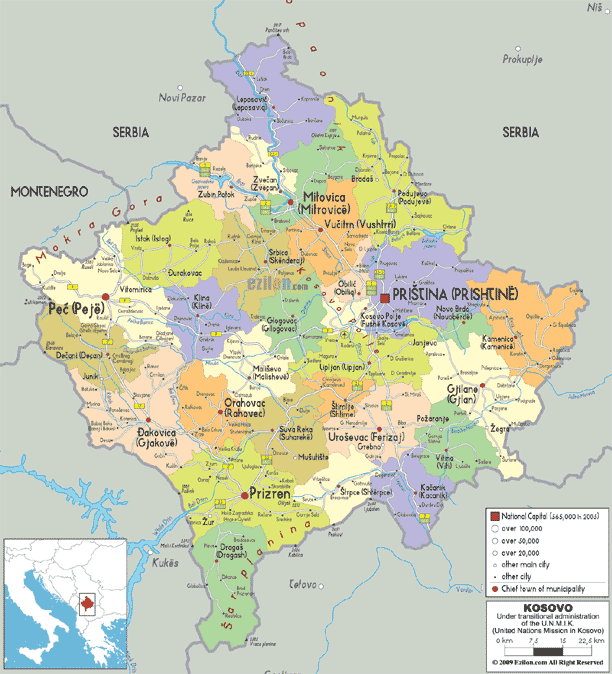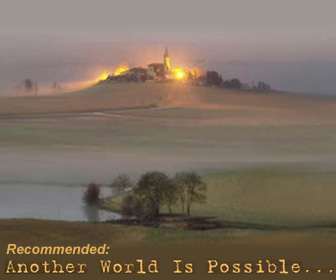| « God Told Me to Tell You This | Epstein Maxwell Secrets Buried on Little St. James Compound » |
Kosovo’s Preparation for the Secession Using Tito’s Yugoslavia as a Blanket
Dr. Vladislav B. Sotirovic
Links with Central Serbia
It has been the standard political-propaganda mantra since 1968 (during the first anti-Yugoslav mass demonstrations in Kosovo by local Albanians) of Kosovo Albanian (or Shqiptar in the Albanian language) leading figures, political and cultural alike, that the central political authorities of Serbia showed little interest in the Kosovo (in Serbian, Kosovo and Metochia – KosMet) affairs, despite their proclaimed worries for the local Serbian and Montenegrin population in this autonomous province of the Republic of Serbia within the Socialist Federal Republic of Yugoslavia. In a sense, they are right, but these claims reveal more about the overall atmosphere on KosMet than the real lack of interest from the Serbian side. As a matter of fact, Albanian KosMet officials and politicians (being in political-administrative power in the province) did not encourage any forms of links with Central Serbia for the very reason, as it appeared in 1998‒2008, of the territorial secessionism and political independence. Educational, cultural, economic, and other links were gradually diminished, while the same were systematically strengthened with neighboring Albania (wherefrom the KosMet Albanians emigrated to this southern province of Serbia). There were, of course, exceptions, as some KosMet Albanian intellectuals used to encourage cultural links with Central Serbia, especially those who were educated in Belgrade within the areas of theater performances, folklore groups, film, etc.
The situation was, however, unfavourable in many respects for the ethnic Serbs and Central Serbia too. The KosMet – Central Serbia relationship could be promoted and maintained via two principal channels. First, via the indigenous non-Albanian population, and second, by direct contact with local Albanians. In the first case situation was very unfavourable, due to the low human standards of the local inhabitants. The most vital part of non-Albanians had left KosMet, looking for more favourable both political and social living conditions. What has remained are elderly people, in particular in the rural areas, who preferred to remain and die in their birth homes. They are, as a rule, the least educated people and uninterested in the “higher level activities”, like cultural or/political ones. The only exception has been folklore, which appears as a real treasure of the traditional culture. Unfortunately, the political-administrative officials in Belgrade and other cultural centers in Central Serbia did not exploit this possibility, better to say necessity. It has to be noticed on that place that the anti-nationalistic mood, promoted by the communist J. B. Tito’s regime, was sufficiently short- sighted, not to say primitive, to appreciate the issue.
The KosMet non-Albanian population, in particular the Serbs, have lived in isolation for centuries, due to the Albanian environment. The younger, more vital people used to emigrate from the region, the elderly people, mostly peasants, were not much mobile and stayed at home, without going out of the province. On the other hand, Serbs from Central Serbia were reluctant to pay a visit to them, being afraid of the dominant, unfriendly ethnic Albanian surroundings. As a matter of comparison, the situation appears similar to the Dinaric region (the mountainous Dinaric range from the North Croatian Adriatic littoral to Albania), but for different reasons. While Dinaroids are leaving their homelands and migrating to the lowlands, there is no move the other way round, since the region is poor and inhospitable. On the contrary, KosMet is fertile and pleasant for living, but it used to attract Albania’s Albanians only, in particular when the domestic Albanian population became dominant after 1945 (due to the genocide done over the Serbs and Montenegrins). With the feedback mechanism, this asymmetric influx and outflow rose to an exponential rate. But the byproduct we are talking about here is the isolation of the remaining non-Albanian population, which has resulted in the preservation and even degradation of the anthropological features of the KosMet population in general, particularly the non-Albanian minorities.
The national folklore and intercultural connections
The folklore of KosMet Serbs, the music in particular, appears somewhat strange to Belgrade citizens’ eyes and ears, even to the rural Serbian people, but it is exactly the value of the preserved national treasure. KosMet tradition has been something like the Hellenic tradition for modern Greeks, or the troubadour tradition to Western Europeans. As the candle of KosMet life is fading away, this tradition is most probably going to be lost forever.
As for the direct Serbian-Albanian channel of communications, the situation has definitely worsened to the point of extinction. Visits by cultural ensembles to KosMet places became very unpleasant and even risky, as the (real) independent status of the province against the central authorities in Belgrade continued. Due to persistent indoctrination of the Albanian youth, principally by educational means, but mass media means as well, the attitude of young KosMet Albanians towards anything non- Albanian has grown from boycott to outright hatred. The latter has grown on the trunk of under- education of the fast-breeding population, who had no time (and means) to shape the personalities of kids and adolescents in a socially acceptable manner. The Albanian kids used to stone buses and trains passing through the province, even those who were carrying ethnic Albanians themselves. Those kids will later, after June 1999, as adults, blast into air buses carrying Serbs, Montenegrins, and other non-Albanians visiting from the refugee camps their home villages and graveyards.
For the majority of the citizens of Serbia outside KosMet (in fact, ethnic Serbs), the province has always been a place for pilgrimage, in particular for the religious and educated people. The oldest and most valuable (medieval) Serbian Christian Orthodox monasteries are in KosMet, for very good reasons, for the present-day province used to be the core of the Serbian state and culture for centuries, before Ottoman Turks arrived in the Balkans in the mid-14ᵗʰ century. Nevertheless, this religious-patriotic pilgrimage was practically stopped when the Kosovo Albanian politics for secession took conspicuous form. It was exactly for this reason that sacral objects, like monasteries and churches, have been especially chosen as targets of the secessionists, as proof of the historical presence of the Serbs in the province.
However, before the open Kosovo Albanian secessionist movement took place, the local KosMet political non-Albanian leaders used to be used as convenient links with the rest of Serbia. It was they who used to plead for increasing economic and financial help for the province. From the present-day perspective, they were, in fact, used as hostages, with their political careers and posts depending on success in extorting benefits from the Serbian state. Once the “jar has broken”, as an old Serbian saying put it, these “respectable representatives of the non-Albanian population” left the province. There were parallel cases, too. Some Kosovo Albanian leaders, like Mahmut Bakali (1936‒2006), were eagerly promoting “Belgrade policy”, in fact, the line of the ruling party, blaming local Albanian nationalism, etc. However, when the party U-turn in 1987 occurred (in favor of defending Serbian human and national rights in Kosovo and Metochia), they completely changed the political tune.¹
Kosovo Albanians and Croatia
It has to be elaborated here on the relations of KosMet with other regions of ex-Yugoslavia. As the time from WWII was elapsing, the number of Kosovo Albanian students studying in Belgrade (and other Serbian educational centers) diminished, with the rise of the number of those going to Zagreb (capital of Croatia) and eventually Ljubljana (capital of Slovenia). Zagreb was a particularly convenient destination for at least two reasons. First, Croats speak the same language as Serbian Serbs, which KosMet population spoke, so there is no language barrier. Second, the anti-Serb(ian) feeling among Croats was a very good springboard for Albanian own tribal and political aims. When the real troubles in Yugoslavia began in 1990, many Kosovo Albanians found a place in the Croatian military sector, participating in the ethnic cleansing of the Serbs from Croatia for the next four years. Though the statistics of this kind have never been disclosed, presumably a great number of young Kosovo Albanians took part in the so-called by Croats “Domovinski rat” (“Patriotic War”) during the 1991−1995 period. Presumably, those instances when these engagements could not be concealed, as the case of the so-called Medački Džep (September 9‒14ᵗʰ, 1993) in Lika near Gospić (Croatia) will show, were just top of the iceberg. Another effect of these links with Zagreb will show up in the form of Croat political support for Kosovo Albanians for the “just case of Albanians under the cruel oppression by Serbs”. To Croat nationalists and Serbophobes, it was a great opportunity to prove the thesis that Serbs are oppressors “by nature” and that “Croat sufferings in Yugoslavia” were not the product of a Croat fantasy. A book on KosMet issue was published in Zagreb, showing sympathy with ”poor Albanians”. The case in point was the book by Zagreb economist, Dr. Branko Horvat (1928‒2003) (otherwise a political adviser of a leading Croat non-communist leader at the time). Though he was not a historian or a political analyst, he found it profitable to present his picture of the province he was not familiar with at all.
Kosovo Albanians in the ruling structure of Serbia
One particular link with the state of Serbia as a whole was through the Albanian politicians engaged in the ruling structure in Belgrade. Some of them occupied very high positions in the Party (and thus in the state) hierarchy. The best, though somewhat absurd, example was that of Kosovo Albanian Sinan Hasani (1922‒2010, died in Belgrade), at the time the head of the Yugoslav state, elected after “the key” method (from May 15ᵗʰ, 1986 to May 15ᵗʰ, 1987). The latter was used, after J. B. Tito died in 1980, to ensure “equipartition” in the ruling institutions at the federal or republic level. Nevertheless, it has to be stressed that the policy of equipartition aimed at the regional representatives, not ethnic ones. Long after he left the temporary President of the Presidency position (one-year term), it was found that he was not a citizen of Yugoslavia at all! This affair illustrates well the problem of evidence, even when the most important positions, either within the federation or the republic, were concerned. For the matter of comparison, as is well known, a person not born in the USA (even having US citizenship) cannot even be a candidate for the President, not to mention a non-citizen one. The question arises: if it happened to the Presidency in Yugoslavia, how much may one expect to control the origin and citizenship of (tens of?) thousands of immigrants from Albania, crossing the (nonexistent) borders between Serbia (Kosovo) and Albania during and after the 1998‒ 1999 Kosovo War? This appears to be a general question of the inference into the KosMet situation, which has always been through the local Kosovo Albanian institutions, never independently.
Another prominent case concerning Kosovo Albanian attitude towards the common (Yugoslav) state has been Azem Vlasi (born in 1948). When he was a teenager, he was chosen to deliver the baton (relay) to Marshal Tito, on the occasion of his alleged birthday, May 25ᵗʰ, celebrated in Belgrade at the football stadium (of FC Partizan).² When the “Baton of Youth” was handed over to Josip Broz Tito at the Partizan’s stadium in Belgrade on May 25ᵗʰ, 1979, it was he who stood next to Tito, while the baton was handed over by a young Albanian woman from Kosovo, Sanija Hiseni. This political-ideological ceremony was, actually, taken over (“borrowed”) from the Kingdom of Yugoslavia (between the two world wars), when practiced for King Alexander Karađorđević (murdered in Marseille on October 9ᵗʰ, 1934).³ Subsequently, Kosovo Albanian Azem Vlasi became the top youth leader in Socialist Yugoslavia, the President of the Yugoslav Youth organization from 1974 to 1978, a sort of Tito-Jugend. He used to be as close to J. B. Tito as possible, both symbolically and literally, buttering him up and securing his projected highest rank position for the future.⁴ For instance, in 1978, Azem Vlasi was staying in Brioni (Tito’s favorite island resort near the peninsula of Istria close to Italy), when the baton was handed over to the lifelong president of the Socialist Federal Republic of Yugoslavia for the first and only time outside of Belgrade. Nevertheless, Azem Vlasi will play a prominent role in the Kosovo Albanian secessionist movement from Serbia in the 1990s.
-###-
| Dr. Vladislav B. Sotirovic Ex - University Professor Research Fellow at Centre for Geostrategic Studies Belgrade, Serbia © Vladislav B. Sotirovic 2025 www.geostrategy.rs sotirovic1967@gmail.com |
 |
¹Endnotes:
Particularly nasty example was demonstrated by M. Bakali at the Hague Tribunal.
² The real Tito’ birthday, in fact, was May 7th (1892). Officially, May 25th was not celebrated in Yugoslavia as Tito’s (false) birthday but rather as the “Youth Day”.³ A similar sort of ritual was practiced in Nazi Germany for Adolf Hitler.
⁴ This kind of entering under the skin behaviour will show up later in Kosovo Albanian securing American support, manners which will, in the case of the U.S. President Bill Clinton, take grotesque dimensions.



